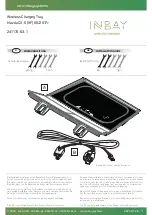
After Driving Off-Road
Off-road operation puts more stress on your vehicle than
most on-road driving. After going off-road, it is always a
good idea to check for damage. That way you can get any
problems taken care of right away and have your vehicle
ready when you need it.
•
Completely inspect the underbody of your vehicle.
Check tires, body structure, steering, suspension, and
exhaust system for damage.
•
Check threaded fasteners for looseness, particularly on
the chassis, drivetrain components, steering, and sus-
pension. Retighten them if required and torque to the
values specified in the Service Manual.
•
Check for accumulations of plants or brush. These
things could be a fire hazard. They might hide damage
to fuel lines, brake hoses, axle pinion seals, and
propeller shafts.
•
After extended operation in mud, sand, water, or
similar dirty conditions, have brake rotors, wheels,
brake linings, and axle yokes inspected and cleaned as
soon as possible.
WARNING!
Abrasive material in any part of the brakes may cause
excessive wear or unpredictable braking. You might
not have full braking power when you need it to
prevent an accident. If you have been operating your
vehicle in dirty conditions, get your brakes checked
and cleaned as necessary.
•
If you experience unusual vibration after driving in
mud, slush, or similar conditions, check the wheels for
impacted material. Impacted material can cause a
wheel imbalance and freeing the wheels of it will
correct the situation.
5
STARTING AND OPERATING
295
Summary of Contents for 2010 Nitro
Page 2: ......
Page 6: ...6 INTRODUCTION...
Page 116: ...116 UNDERSTANDING THE FEATURES OF YOUR VEHICLE...
Page 117: ...3 UNDERSTANDING THE FEATURES OF YOUR VEHICLE 117...
Page 118: ...118 UNDERSTANDING THE FEATURES OF YOUR VEHICLE...
Page 181: ...INSTRUMENT CLUSTER 4 UNDERSTANDING YOUR INSTRUMENT PANEL 181...
Page 262: ...262 UNDERSTANDING YOUR INSTRUMENT PANEL...
Page 316: ...316 STARTING AND OPERATING...
Page 364: ......
Page 378: ......
Page 446: ......
Page 457: ...INDEX 10...
















































